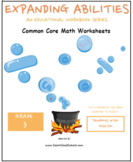Grade 3, CCS: Algebra for students with Autism
- PDF
Also included in
- Third Grade Math Bundle - Common Core Standards - For Students with Autism SpectrumStudents on the spectrum need a multi-media approach including: visual images, an auditory reinforcement, a tactile involvement and key words presented in different contexts 3 - 5 times. Accessibility suggestions:Price $12.95Original Price $15.75Save $2.80
- This educational resource pack includes: visual and tactile enhancements. To save ink and paper, an application like Google Classroom could be utilized. This educational resource pack requires: scissors, glue, a ruler and a pencil. Accessibility suggestions: Go to your device “Settings” where youPrice $56.53Original Price $74.85Save $18.32
- This educational resource pack for students on the Autism Spectrum includes:visual and tactile enhancements.To save ink and paper, an application like Google Classroom could be utilized.This educational resource pack requires a ruler and colored pencils. Students on the autism spectrum need a multiPrice $9.85Original Price $9.85
Description
“Operations and Algebraic Thinking” For Students with Autism - Grade 3
This educational resource pack enhanced with : color coding, audio links and visual images. Students on the spectrum need a multi-media approach including: visual images, an auditory reinforcement, a tactile involvement and key words presented in different contexts 3 - 5 times.
Here is a link to our teaching strategies for students with autism: https://www.teacherspayteachers.com/Product/Autism-Spectrum-Educational-Treatments-1023424
The instructor will require a RULER, SCISSORS, GLUE, and COLORED PENCILS for students.
Follow the Order of Operations for these problems: P E M D A S or the sentence: "Please Excuse My Dear Aunt Sally"
Here is a link: https://www.teacherspayteachers.com/Product/Grades-3-6-Orders-of-Operations-or-PEMDAS-3988127
Worksheet 1: CCSS.MATH.CONTENT.3.OA.A.1 Represent and solve problems involving multiplication and division.
Worksheet 2: CCSS.MATH.CONTENT.3.OA.A.2 Interpret whole-number quotients of whole numbers, e.g., interpret 56 ÷ 8 as the number of objects in each share when 56 objects are partitioned equally into 8 shares, or as a number of shares when 56 objects are partitioned into equal shares of 8 objects each. For example, describe a context in which a number of shares or a number of groups can be expressed as 56 ÷ 8.
Worksheet 3: CCSS.MATH.CONTENT.3.OA.A.3 Use multiplication and division within 100 to solve word problems in situations involving equal groups, arrays, and measurement quantities, e.g., by using drawings and equations with a symbol for the unknown number to represent the problem.1
Worksheet 4:CCSS.MATH.CONTENT.3.OA.A.4 Determine the unknown whole number in a multiplication or division equation relating three whole numbers. For example, determine the unknown number that makes the equation true in each of the equations 8 × ? = 48, 5 = _ ÷ 3, 6 × 6 = ?
Worksheet 5: Understand properties of multiplication and the relationship between multiplication and division. CSS.MATH.CONTENT.3.OA.B.5 Apply properties of operations as strategies to multiply and divide.2 Examples: If 6 × 4 = 24 is known, then 4 × 6 = 24 is also known. (Commutative property of multiplication.) 3 × 5 × 2 can be found by 3 × 5 = 15, then 15 × 2 = 30, or by 5 × 2 = 10, then 3 × 10 = 30. (Associative property of multiplication.) Knowing that 8 × 5 = 40 and 8 × 2 = 16, one can find 8 × 7 as 8 × (5 + 2) = (8 × 5) + (8 × 2) = 40 + 16 = 56. (Distributive property.) Worksheet 6: CCSS.MATH.CONTENT.3.OA.B.6 Understand division as an unknown-factor problem. For example, find 32 ÷ 8 by finding the number that makes 32 when multiplied by 8.
Worksheet 7: Multiply and divide within 100. CCSS.MATH.CONTENT.3.OA.C.7 Fluently multiply and divide within 100, using strategies such as the relationship between multiplication and division (e.g., knowing that 8 × 5 = 40, one knows 40 ÷ 5 = 8) or properties of operations. By the end of Grade 3, know from memory all products of two one-digit numbers. Solve problems involving the four operations, and identify and explain patterns in arithmetic. Worksheet 8: CCSS.MATH.CONTENT.3.OA.D.8 Solve two-step word problems using the four operations. Represent these problems using equations with a letter standing for the unknown quantity. Assess the reasonableness of answers using mental computation and estimation strategies including rounding.3 Worksheet 9: CCSS.MATH.CONTENT.3.OA.D.9 Identify arithmetic patterns (including patterns in the addition table or multiplication table), and explain them using properties of operations. For example, observe that 4 times a number is always even, and explain why 4 times a number can be decomposed into two equal addends.
To see more of the “StoneSoupSchool.com” store with other great teaching resources for culture, holidays, ESL, ELLs, literature, history, science, easy readers, math, etc. as they become available, go to: TeachersPayTeachers.com or... http://www.StoneSoupSchool.com
“StoneSoupSchool.com provides digital educational strategies for every student based on their abilities.”
I wish to dedicate this to all my students past and present. Photo credits go to Dreamstime. Sincerely, Mrs. Cheryl Lynn Peele
Here is a link to our teaching strategies for students with autism: https://www.teacherspayteachers.com/Product/Autism-Spectrum-Educational-Treatments-1023424
Here is a link to additional worksheets for students with autism:
https://www.teacherspayteachers.com/Store/Stone-Soup-School/Category/Autism-Spectrum-141203
Click here to Stone Soup School and new products:
https://www.teacherspayteachers.com/Sellers-Im-Following/Add/Stone-Soup-School
Please help us out by rating this product.
Thank You!








